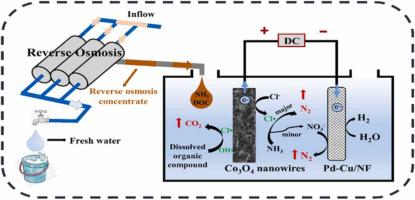Journal of Hazardous Materials ( IF 12.2 ) Pub Date : 2021-11-02 , DOI: 10.1016/j.jhazmat.2021.127662 Yan Zhang 1 , Wenjing Tang 1 , Jing Bai 2 , Jinhua Li 1 , Jiachen Wang 1 , Tingsheng Zhou 1 , Xiaohong Guan 3 , Baoxue Zhou 4

|
Reverse osmosis concentrate (ROC) from wastewater reclamation has posed significant disposal challenges due to its highly concentrated NH3-N, chloride ion and bio-refractory organics, and developing technologies for their removal are essential. Herein, we developed an efficient electrochemical system to remove total nitrogen and dissolved organic compound (DOC) simultaneously mediated by chlorine radical (Cl•), which is generated by activation of chloride ion existing in ROC on an inexpensive, three-dimensional Co3O4 nanowires. Results showed that the total nitrogen and total organic carbon removal were 98.2% and 56.9% in 60 min for synthetic ROC with 56 mg/L of NH3-N and 20 mg/L of DOC. The utilization of Co3O4 nanowires enhanced NH3-N degradation by 2.58 times compared with Co3O4 nanoplates, which were 1.69 and 17.5 times these of RuO2 and Pt. We found that structural Co3+/Co2+ acts as cyclic catalysis to produce Cl• via single-electron transfer, which convert NH3-N to N2 and lead to faster DOC degradation. This architecture provides abundant catalytic sites and sufficient accessibility of reactants. Small amount of nitrate generated by oxidation of NH3-N was further reduced to N2 on Pd-Cu/NF cathode. These findings provide new insights for utilization of waste Cl– and development of novel electrochemical system for ROC disposal.
中文翻译:

氯自由基介导的 3D Co3O4 纳米线阳极高效去除废反渗透浓缩物中的总氮和溶解的有机化合物
来自废水回收的反渗透浓缩液 (ROC) 因其高浓度的 NH 3 -N、氯离子和生物难降解有机物而带来了巨大的处理挑战,因此开发去除它们的技术至关重要。在此,我们开发了一种有效的电化学系统,可同时去除由氯自由基 (Cl•) 介导的总氮和溶解有机化合物 (DOC),氯自由基是通过在廉价的三维 Co 3 O上激活 ROC 中存在的氯离子而产生的。 4纳米线。结果表明,NH 3 -N 56 mg/L、20 毫克/升 DOC。与Co 3 O 4 纳米片相比,Co 3 O 4纳米线的使用增强了NH 3 -N降解2.58倍,分别是RuO 2和Pt的1.69倍和17.5倍。我们发现结构Co 3+ /Co 2+作为循环催化通过单电子转移产生Cl•,将NH 3 -N 转化为N 2并导致更快的DOC 降解。这种结构提供了丰富的催化位点和足够的反应物可及性。NH 3 -N氧化生成的少量硝酸盐进一步还原为N 2在 Pd-Cu/NF 阴极上。这些发现为废物 Cl的利用和开发用于 ROC 处理的新型电化学系统提供了新的见解。











































 京公网安备 11010802027423号
京公网安备 11010802027423号